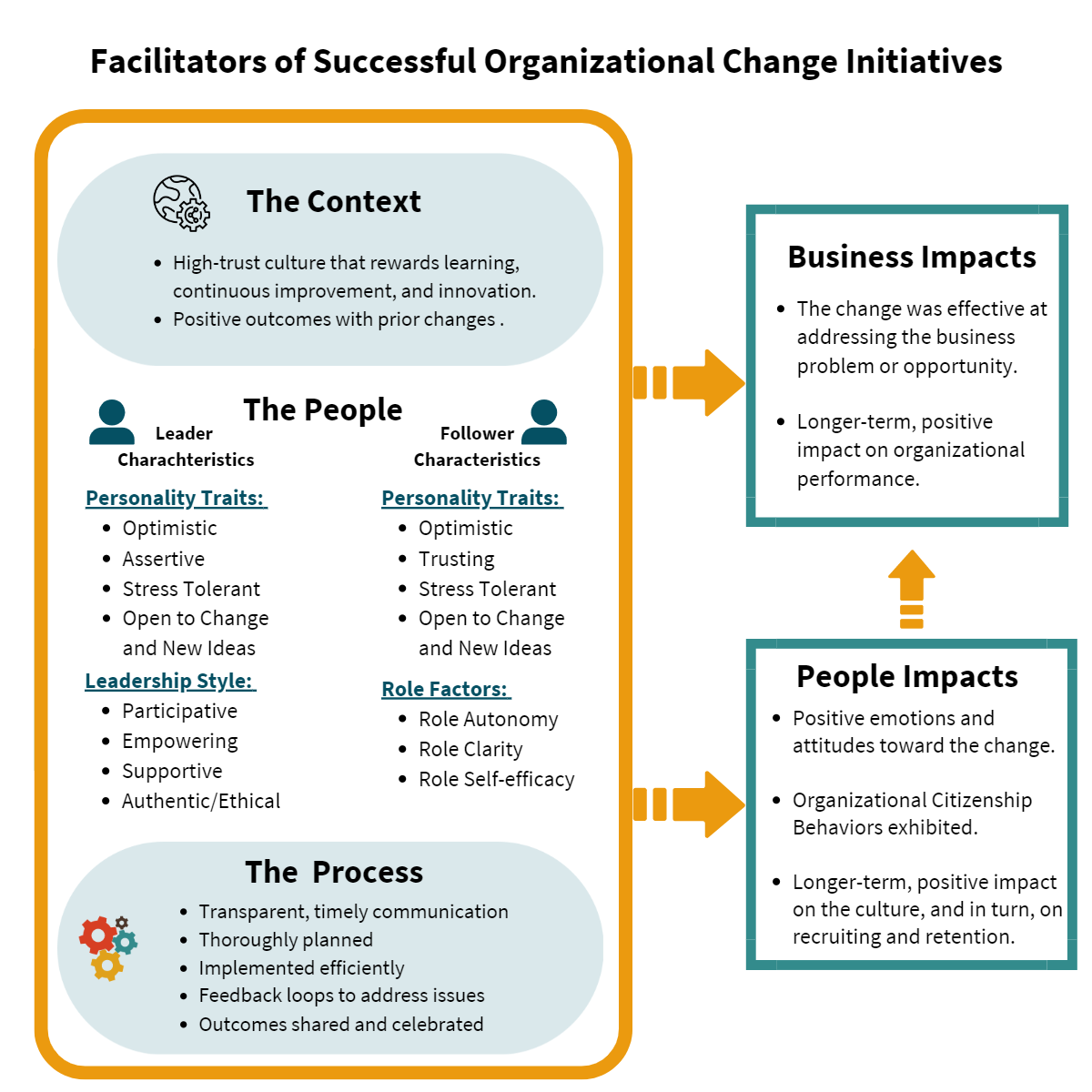Assess for Change Readiness
The old adage that the only constant is change is more true now than ever. For organizations to compete, they need to be agile and their people need to drive and adapt to change quickly.
Assess Personality Traits Pre-Hire
Research shows that the personality traits that are most predictive of change readiness and adaptive performance include: Positive Emotions (i.e., optimism, which is a facet of Extraversion), Openness (Facets: new ideas and actions/experiences), and Emotional Steadiness (i.e., stress tolerance, which includes negative emotions). Additionally, people who are high on Assertiveness (i.e., a facet of Extraversion) are more likely to engage in OCBs targeted toward leading organizational change.
Knowing where a person falls on these traits help you to predict how likely they are to experience positive and negative emotions related to the change, the flexibility of their schemas, and the behaviors they are inclined to exhibit. Using a psychometrically sound measure of The Big 5 personality traits pre-hire will help you to hire people who are naturally more ready for change. If you do not have objective data, you will need to rely on more subjective approaches to get a gauge on these propensities via one-on-one and small group discussions, as well as observations of behavior before, during, and after the change.
Leadership Style of your Leaders
Research shows that the following leadership behaviors are positively related to outcomes of organizational change initiatives: Encouraging Participation (i.e., involving people in decisions related to the change), Showing Consideration (i.e., displaying empathy, listening well, and offering support), Giving Autonomy (i.e., empowering people to enact the change), and Displaying Authenticity (i.e., being transparent and honest).
Knowing what type of leadership style your leaders are employing will help you to identify how prepared they are to successfully lead the team through change. At PCI, we use a psychometrically sound, 10-minute survey that measures these aspects of leadership. Administering this pre-hire will help you to select leaders who are more “change ready.” Feedback from direct reports could also shed light on how often the leader is exhibiting these behaviors.
Set People Up for Success
Using an objective assessment as part of the hiring process will help you to select more people who are ready for change. Still, there will always be a certain percentage of your workforce that is less naturally equipped to deal and lead change. Research has shown that the people-focused activities described below can facilitate the success of change initiatives:
Identify and Support “at risk” leaders. Leaders who do not have the personality traits or leadership style that is most predictive of success should be supported with a developmental plan. This may include formal training, coaching, pairing with a strong change leader, and more frequent check-ins during the change process.
Identify and Support “at risk” followers. Keep in mind that it is not just the squeaky wheels that you need to pay extra attention to. Some people quietly accept change on the surface but over time, you see changes in their behavior that signal something is wrong. This is when objective assessment data can be especially helpful. Because going through change is stressful for some people, it can deplete their resources and make it more difficult for them to maintain effective work behaviors. So, if you see a decline in performance, don’t assume it is intentional. Keep open dialogue with these individuals and provide them with extra support.
Encourage “Generative” Dialogue: Whether one-on-one or in groups, people should be encouraged to share their thoughts and feeling, including those that are negative. Often, people just want to be heard and reassured, and this gives you opportunities to provide validation, clarification, and support.
Minimize Role Ambiguity: Be transparent and timely in sharing information about how the person’s job will change and what support they will have to adapt to it.
Increase Autonomy and Engagement: Giving people a sense of control is crucial in ambiguous situations. That’s why giving people freedom and a voice in the process leads to a stronger commitment to the change and ultimately, better outcomes.
Prompt Cognitive Shifts: To target maladaptive schemas, make sure that everyone understands WHY the change is happening, WHAT impact the change will have on them and the business, and HOW the success of the change will be measured and reported back to them.
Prompt Emotional Shifts. The goal is to help people minimize negative and increase positive emotions toward the change. Pairing change-related activities with things that evoke positive emotions (e.g., a fun activity; group interaction) can do just that. Have the team come up with ways to make the experience more enjoyable.
Because of the complexity of organizational change and all the moving parts, attention can be swayed toward process and procedures. Yet the people side of things can make or break the success of the initiative. If you are on a change committee, be sure to identify someone who is responsible and accountable for setting the teams up for success.
References
Chiaburu, D., Oh, I., Berry, C., Li, N., & Gardner, R. (2011). The five-factor model of personality traits and organizational citizenship behaviors: A Meta-Analysis. Journal of Applied Psychology, 96(6),1140-1166.
Huang, J., Ryan, A., Zabel, K., & Palmer, A. (2014). Personality and adaptive performance at work: A meta-analytic investigation. Journal of Applied Psychology, 99(1), 162-179.
Oreg, S. & Berson, Y. (2019). Leaders’ impact on organizational change: Bridging theoretical and methodological chasms. Academy of Managemetn Annuls, 13(1), 272-307.
Rafferty, A. & Minbashian, A. (2019). Cognitive beliefs and position emotions about change: Relationships with employee change readiness and change-supporting behaviors. Human Relations 72(10), 1623-1650

